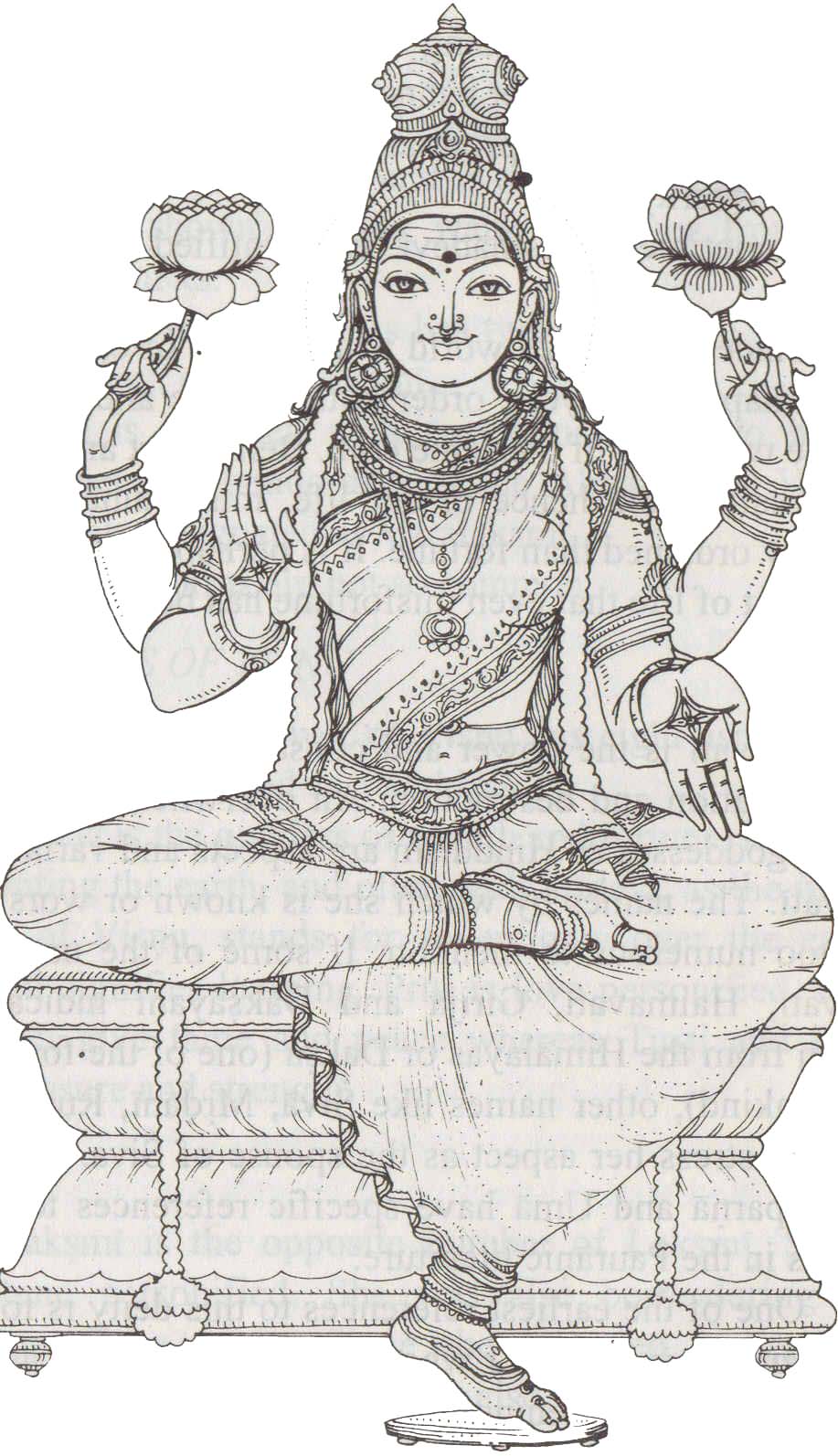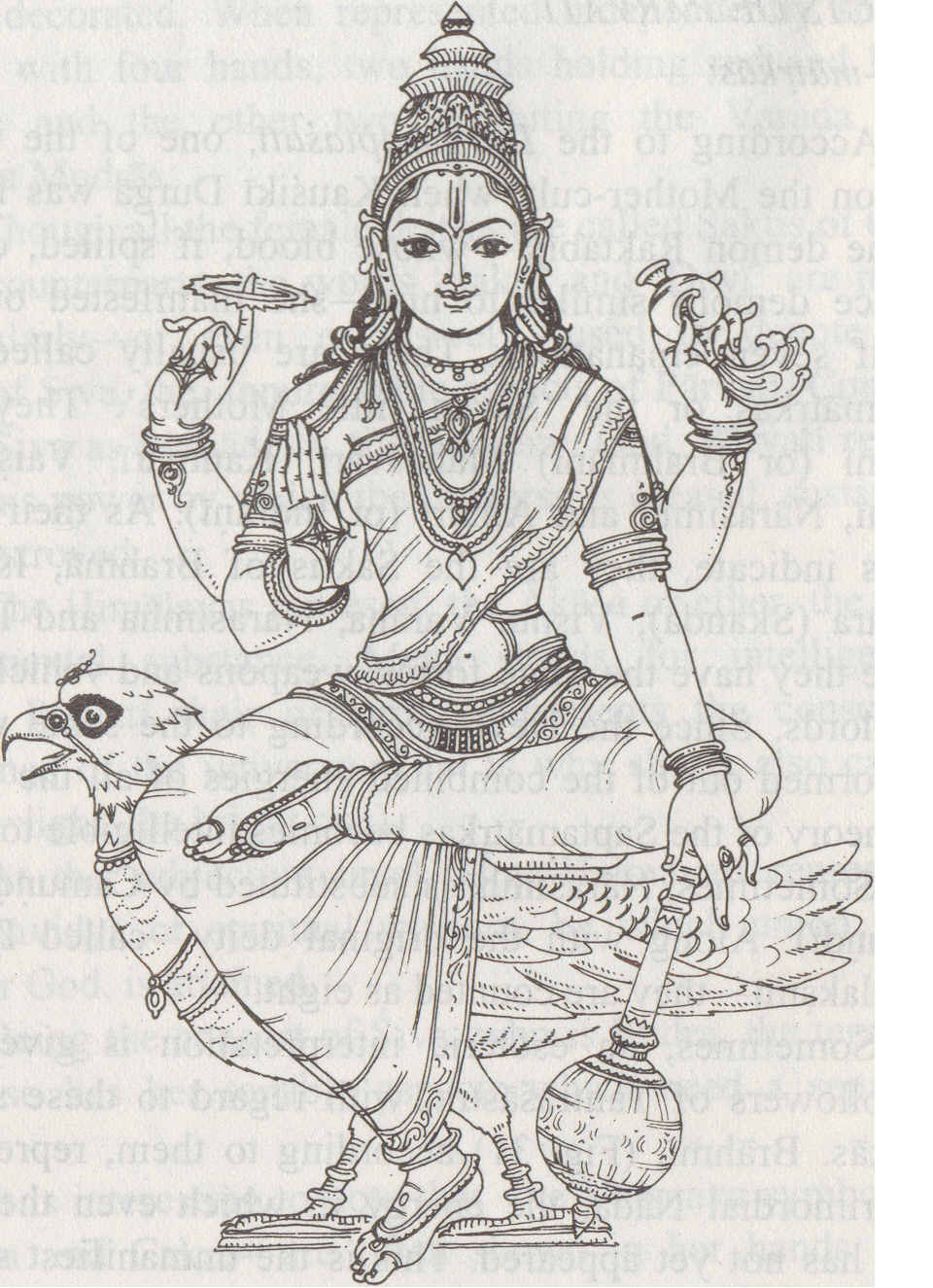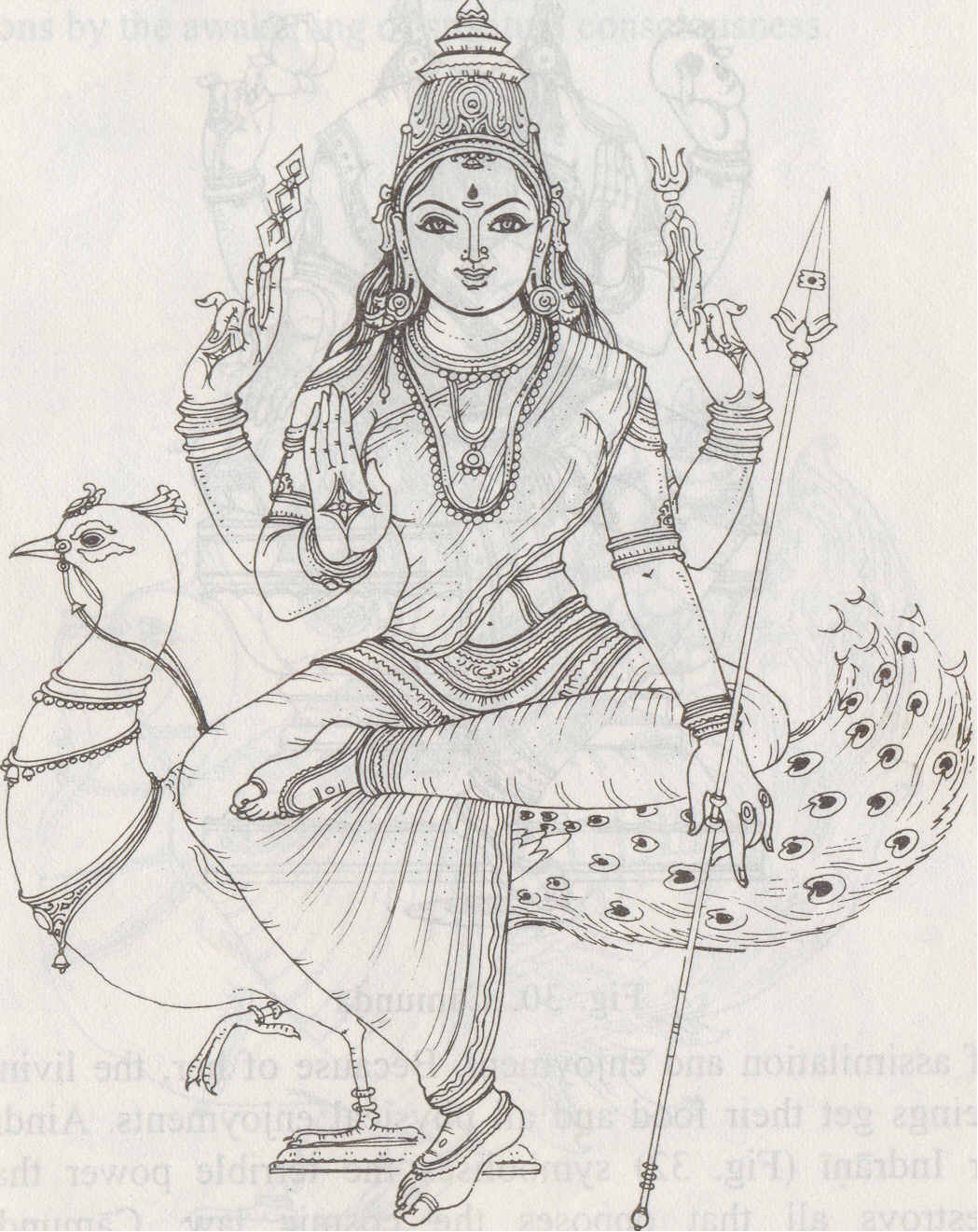| |

ParvatI is the power
and consort of Siva,
the god of
disintegration and
destruction. An
overwhelming
majority of the
goddesses of
Hinduism are aspects
and variations of
ParvatL The names by
which she is known
or worshipped are
too numerous to
mention. If some of
the names like
ParvatI, HaimavatI,
Girija and
Dak~ayaI).I indicate
her origin from the
Himalayas or Dak~a
(one of the
forefathers of
mankind), other
names like Siva,
MrQanI, RudraI).I
and SarvaI).I stress
her aspect as the
spouse of Siva.
Still other like
ApafI).a and Uma
have specific
references to
certain stories in
the Pauranic
literature.
One of the earliest
references to this
deity is found in
the Kenopani~ad
(3.12) where she is
mentioned as 'Uma
HaimavatI'
enlightening Indra,
the king of gods,
about Brahman, the
Absolute or God.
This reference is
enough to
. conclude that the
worship of this
goddess is very
ancient.
According to the
Paural)ic accounts,
in her 'first'
incarnation, she was
Dak~ayal)l, the
daughter of Dak~a
and PrasUti, and
married to Lord
Siva. Vnable to
understand Lord
Siva's greatness,
Dak~a once reviled
him and started
harbouring hatred
towards him. When he
undertook the
performance of a
great sacrifice, the
notable exception
among the
dignitaries invited
was Siva himself.
Much against the
advice of her spouse
Dak~ayal)l went to
the sacrifice
uninvited and being
slighted, ended her
life by igniting
herself through the
fire of yoga. Hence
she came to be known
as San, the chaste
one. She was next
reborn as Parvan,
the daughter of
Himavan, and Mena.
After performing
intense austerities
she succeeded in
pleasing Siva and
making him accept
her again as his
consort.
During the
performance of these
severe austerities,
she refused to eat
even dry leaves to
sustain herself and
hence got the
appellation Apafl)a.
Her mother Mena
unable to see her
dear daughter
languishing by
austerities, tried
to dissuade her by
the words, 'V ma'
(=my dear,don't do
like this!) which
became her another
name (Vma). Being
the daughter of the
Himalayas (the abode
of snow) she has to
be Gaurl (the white
one). As the mother
of the universe she
is Amba and Ambika,
both the words
meaning
'mother' .
Like her consort
Siva, she also has
two aspects: the
mild and the
terrible. As Parvan
or Vma she
represents the
mild aspect. In this
aspect she is
usually shown with
Siva. . Then she has
only two hands, the
right one holding a
blue
. lotus and the left
hanging loosely by
the side. The image
is richly decorated.
When represented
independently she is
shown with four
hands, two hands
holding red and blue
lotuses and the
other two exhibiting
the Varada and
Abhaya Mudras.
Though all the
female deities are
called Saktis of
their male
counterparts, the
words 'Sakti' and 'DevI'
are more
particularly-or even
exclusively-used to
denote the Sakti of
Siva, the
innumerable aspects
of ParvatL
Consid?ering Siva as
Mahadeva, the
Supreme God, Parvatl
repre?sents his
power by which the
universe is created,
sustained and
destroyed.
The Himalayas
represent the Akasa
or ether, the first
fundamental
substance. Mena
stands for
intelligence. Hence
Parvatl their
offspring,
represents the
conscious substance
of the universe.
That is why she is
also called Uma
(=light, the bright
one).
At the subjective
level, Uma-Haimavatl
represents
Brahmavidya or
spiritual wisdom, by
which union with
Siva or God, is
attained.
Being the consort of
Siva, who is Rudra,
the terrible, she
also has her
terrible aspects
which need a
separate study.
It is interesting to
note that the
Vai~l)ava symbols-Sailkha
and Cakra-are often
shown in her hands
also. Though the
Pural)as describe
her as the sister of
Vi~l)u, it is
possible that Vi~l)u
is considered as the
active power of
Siva and hence these
symbols in the hands
of the DevL This
surmise is
strengthened by the
fact that in the
Haryardha-murti of
Siva, the left half
is Vi~l)u and in the
ArdhanarIsvara form,
DevI forms the left
half.
ASPECTS OF PARVATI
Sapta-matrkas:
According to the
Durgasaptasatl, one
of the basic texts
on the Mother-cult,
when KausikI Durga
was fight-ing the
demon RaktabIja-whose
blood, if spilled,
could
produce demons
similar to him-she
manifested out of
herself seven
emanations. These
are usually called
the Saptamatrkas or
the' Seven little
Mothers'. They are
BrahmI (or Brahmal)I)
MahesvarI, KaumarI,
Vai~l)avI, VarahI,
NarasimhI and AindrI
(or Indral)I). As
their very names
indicate, they are
the Saktis of
Brahma, ISvara,
Kumara (Skanda),
Vi~l)u, Varaha,
Narasimha and Indra.
Hence they have the
same forms, weapons
and vehicles as
their lords. Since
the DevI, according
to the same work,
was formed out of
the combined
energies of all the
gods, this theory of
the Saptamatrkas
becomes intelligible
to us.
Sometimes, NarasimhI
is substituted by
Camul)qa (or
Camul)qI). Along
with the original
deity-called Durga
Mahalak~mI-they are
counted as eight.
Sometimes, an
esoteric
interpretation is
given by the
followers of
Tantrasastra, with
regard to these
seven matrkas.
BrahmI, (Fig. 31)
according to them,
represents the
primordial Nada, the
energy in which even
the first throb has
not yet appeared.
This is the
unmanifiest sound
(Logos), the origin
of all creation. It
is the same as the
substance or energy
represented by the
Pral)ava (Om). When
BrahmI creates the
universe, the power
of Vai~l)avI (Fig.
28) gives it a
definite shape. The
symmetry, beauty,
organisation and
order in the
universe are the
work of
. Vai~l)avL
Mahesvari (Fig. 33)
stands for the power
that devi gives
individuality to the
created beings. She
resides in the
hearts of all and
makes them play,
like the dolls
mounted on a
machine. Kaumarl
(Fig. 29), the ever
youthful deity,
represents the ever
present force of
aspiration of the
evolving soul. She
is 'Guruguha, (Guruguha
being one of the
names of Kumara or
Skanda whose energy
she is), the 'Guru'
(guide, teacher) in
the 'Guha' (the cave
of the heart, the
intellect). Varahl
(Fig. 34) is the
all-consuming power
Camunda of
assimilation and
enjoyment. Because
of her, the living
beings get their
food and all
physical enjoyments.
AindrI or IndraI)I
(Fig. 32) symbolises
the terrible power
that destroys all
that opposes the
cosmic law. CamuI)Qa
(Fig. 30) is the
force of
concentrated
awareness, the power
of spiritual
awakening in the
heart, that devours
the cease?less
activity of the
immature mind and
uplifts it to the
highest level.
RaktabIjasura is
actually the mind,
each wave of which
gives rise to other
waves. Killing of
this Raktablja by
CamuI)Qa means the
destruction of the
mental
modifica?tions by
the awakening of
spiritual
consciousness.
These deities are
generally
represented as red
in colour and with
two hands, holding a
skull and a lotus.
However, since they
are Saktis of the
above-mentioned
gods, they are shown
more often as female
replicas of the male
deities.
Sometimes each deity
is assigned a tree
as specially sacred
to it. For instance:
Udumbara (fig tree)
for KaumarI,
Asvattha (peepal
tree) for VaiglavI
and the Karafija
(Indian beech)
forVarahI.
They are usually
grouped together
with Gal).esa and
VIrabhadra flanking
on either side and
shown on panels in
the Siva temples.
Occasionally they
have a separate
shrine built for
them. The order or
arrangement varies
according to the
effect desired. If
the safety of the
village is desired
BrahmI is installed
in the centre. If
increase in the
popula?tion is the
goal, Camul).<;Ia
occupies the central
place.
Dasamahavidyas:
Ten aspects of Sakti
are sometimes
described in Tantric
works. They are
termed 'Dasamahavidya's.
These are the
representations of
transcendent
knowledge and power,
the sources of all
that is to be known.
The first is KaII,
the goddess of time,
that destroys
everything. Tara,
the second, is the
power of the golden
embryo (Hiral).yagarbha)
from which the
universe evolves.
She also stands for
void or the
boundless space. The
third is ~o<;lasI.
The word literally
means 'one who is
sixteen years old.'
She is the
personification of
fullness, of
perfec?tion.
BhuvanesvarI, the
fourth Vidya,
represents the
forces of the
material world,
whereas BhairavI the
fifth, stands for
desires and
temptations leading
to destruction and
death. Then comes
Chinnamasta, the
naked deity holding
her own severed head
in hand and drinking
her own blood! She
simply represents
the continued state
of self-sustenance
of
the created world in
which are seen
continuous
self-destruction and
self-renewal, in a
cyclic order.
DhumavatI, the
seventh, personifies
the destruction of
the world by fire,
when only smoke (Dhuma)
from its ashes
remains. She is
sometimes identified
with Alak~mI or
Jye~!hadevI. The
eighth Vidya, Bagala,
is a crane-headed
goddess, and
rep?resents the ugly
side of living
creatures like
jealously, hatred
and cruelty. MatangI,
the ninth, is the
embodiment of the
power of domination.
The tenth and the
last, Kamala, is the
pure consciousness
of the self,
bestowing boons and
allaying the fears
of the supplicants.
She is identified
with Lak~mI, the
goddess of fortune.
|
|


